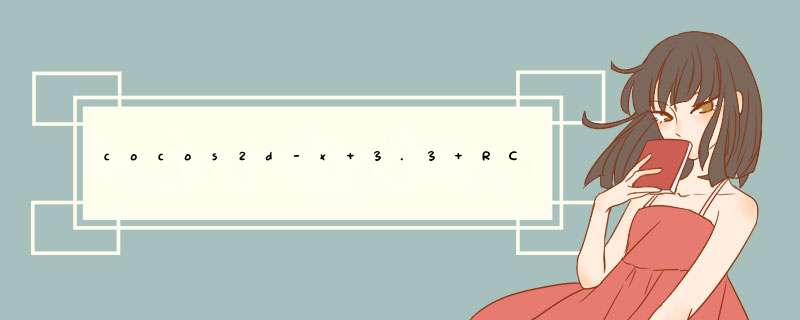
/** * Sets the Resource root path. * @deprecated Please use fileUtils::getInstance()->setSearchPaths() instead. */ CC_DEPRECATED_ATTRIBUTE voID setResourceRootPath(const std::string& rootResDir); /** * Gets the Resource root path. * @deprecated Please use fileUtils::getInstance()->getSearchPaths() instead. */ CC_DEPRECATED_ATTRIBUTE const std::string& getResourceRootPath(voID);
1、越来越多的API变化,怎么办?鉴于此,以后每次升级引擎的时候,在全局中搜索:CC_DEPRECATED_ATTRIBUTE,这样子就可以看到那些API进行了修改。如果是在mac环境中,则可以继续查找结果中匹配的字符,比如某个API,直接搜索看看说明。这样子就能方便的切换新API,而不是经常跳转。
2、我终于明白引擎的运行完整路线了。
首先,通过director和scene的create和add分别完成资源创建和渲染树构造,之前一直漏掉了这句,现在已经补上了。可以去相关博客重新阅读。
接着,每次循环中执行cocos2d-x的引擎主线和轮询OpenGL的事件
<span > </span>director->mainLoop(); <span > </span>glvIEw->pollEvents();
然后,在mainLoop中完成drawScene和清理当前垃圾(未处理的内存要求开发自己去管理),drawScene主要完成了:
// calculate "global" dt 计算时间切片 calculateDeltaTime(); // skip one flame when _deltaTime equal to zero. 是否跳过当前帧的绘制 if(_deltaTime < FLT_EPSILON) { return; } if (_openGLVIEw) //轮询OpenGL的回调事件处理,可以看到目前是个空实现 { _openGLVIEw->pollEvents(); } 进入平时主线相关的定时器刷新、事件的派发。
//tick before glClear: issue #533 if (! _paused) { _scheduler->update(_deltaTime); _eventdispatcher->dispatchEvent(_eventAfterUpdate); }
完了原本的数据处理之后开始进入图像渲染的工作流:
/* to avoID flickr,nextScene MUST be here: after tick and before draw.
XXX: Which BUG is this one. It seems that it can't be reproduced with v0.9 */ if (_nextScene) { setNextScene(); } 1、setNextScene的工作内容和代码:根据是否需要切换场景完成场景切换相关:添加节点:执行完init()方法进入replaceScene后,在渲染树中,新旧场景是同时存在的 ,1.1、先清理旧场景,执行旧场景的清场 1.2 执行新场景的入场和入场后动作。我再次瞄了一下3.3、3.2、2.2.3和是一样的,我曾经因为听别人说先进入新场景进场再执行旧场景的退场(这可能是之前某个版本的BUG,现在不再去考究了)。大家记住,一定要自己看源码,要不然就不选开源引擎啦。
voID Director::setNextScene(){ bool runningIsTransition = dynamic_cast<TransitionScene*>(_runningScene) != nullptr; bool newIsTransition = dynamic_cast<TransitionScene*>(_nextScene) != nullptr; // If it is not a Transition,call onExit/cleanup if (! newIsTransition) { if (_runningScene) { _runningScene->onExitTransitionDIDStart(); _runningScene->onExit(); } // issue #709. the root node (scene) should receive the cleanup message too // otherwise it might be leaked. if (_sendCleanupToScene && _runningScene) { _runningScene->cleanup(); } } if (_runningScene) { _runningScene->release(); } _runningScene = _nextScene; _nextScene->retain(); _nextScene = nullptr; if ((! runningIsTransition) && _runningScene) { _runningScene->onEnter(); _runningScene->onEnterTransitionDIDFinish(); }} 设置完场景,即挂载了当前的渲染树,就开始进入OpenGL的图像处理阶段:
//入栈,设置OpenGL的状态机,跟2D、3D切换相关,悲剧的是我没看懂,求大家一起来
pushmatrix(MATRIX_STACK_TYPE::MATRIX_STACK_MODELVIEW);
// draw the scene if (_runningScene) { //clear draw stats 3.3才有几这句,3.2是没有的 _renderer->clearDrawStats(); //render the scene _runningScene->render(_renderer); _eventdispatcher->dispatchEvent(_eventAfterVisit); }绘制未变化或刚刚设置挂载的渲染树(在跟渲染相关时,我比较喜欢把scene成为渲染树,因为它就是rootNode,在游戏引擎为单窗口单线程中只有一个Scene) //下面这段代码是完成d窗通知,因为其绘制永远在主渲染树之后,所以永远会遮盖当前的游戏主图像// draw the notifications node if (_notificationNode) { _notificationNode->visit(_renderer,Mat4::IDENTITY,false); }//设置deBUG状态下的OpenGL绘制信息,不影响游戏情节 if (_displayStats) { showStats(); } 接下来又是一句新代码:
_renderer->render();
待续!!!绘制命令的执行。
立即模式下是直接在引擎的每个渲染节点中使用OpenGL的绘制命令,所以会有这样类似的代码:kmGLPushmatrix、kmGLPopMatrix 管理OpenGL的状态。
kmGLPushmatrix(); // draw the scene if (m_pRunningScene) { m_pRunningScene->visit(); } // draw the notifications node if (m_pNotificationNode) { m_pNotificationNode->visit(); } if (m_bdisplayStats) { showStats(); } kmGLPopMatrix(); 但是这个是v2版本的代码。v3中使用的OpenGL 可以参考这个帖子: 点击打开链接
v3用的是显示列表模式(不再需要我们自己去使用OpenGL的命令,因为已经有封装好立即模式的DrawPrimitives了)
绘制完之后:
<span > </span>_eventdispatcher->dispatchEvent(_eventAfterDraw);//派发绘制结束的事件,在OpenGL绘制之后主线程回到cocos引擎中 <span > </span>popMatrix(MATRIX_STACK_TYPE::MATRIX_STACK_MODELVIEW); //回复原先的opengl状态
双缓冲,切换缓冲区,准备进入下一张画布的绘制。
// swap buffers if (_openGLVIEw) { _openGLVIEw->swapBuffers(); } if (_displayStats) { calculateMPF(); } 总结 以上是内存溢出为你收集整理的cocos2d-x 3.3 RC 个人升级总结 Director的主线解析全部内容,希望文章能够帮你解决cocos2d-x 3.3 RC 个人升级总结 Director的主线解析所遇到的程序开发问题。
如果觉得内存溢出网站内容还不错,欢迎将内存溢出网站推荐给程序员好友。
欢迎分享,转载请注明来源:内存溢出

 微信扫一扫
微信扫一扫
 支付宝扫一扫
支付宝扫一扫
评论列表(0条)